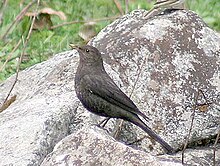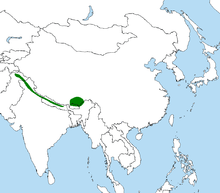
Back Turdus merula maximus Azerbaijani Merla de l'Himàlaia Catalan Turdus maximus CEB Drozd tibetský Czech Turdus maximus Spanish Turdus maximus Basque سیاهتوکای تبتی Persian Tibeti feketerigó Hungarian Tibetaanse merel Dutch Dziłtah tsídiishzhiin NV
| Tibetan blackbird | |
|---|---|

| |
| A female | |

| |
| A male | |
| Scientific classification | |
| Domain: | Eukaryota |
| Kingdom: | Animalia |
| Phylum: | Chordata |
| Class: | Aves |
| Order: | Passeriformes |
| Family: | Turdidae |
| Genus: | Turdus |
| Species: | T. maximus
|
| Binomial name | |
| Turdus maximus (Seebohm, 1881)
| |

| |
| Synonyms[2] | |
The Tibetan blackbird (Turdus maximus) is a species of bird in the thrush family Turdidae. It is found in the Himalayas from northern Pakistan to southeastern Tibet. Originally described as a separate species by Henry Seebohm in 1881, it was then considered a subspecies of the common blackbird until 2008, when phylogenetic evidence revealed that it was only distantly related to the latter species. It is a relatively large thrush, having an overall length of 23–28 centimetres (9–10 inches). Males are blackish-brown all over with darker plumage on the head, breast, wings and tail and dull orange-yellow bills, while females have browner underparts, faint streaking on the throat, and a dull darkish yellow bill. Both sexes may seem slightly hooded. It can be differentiated from the common blackbird by its complete lack of an eye-ring and reduced song.
The Tibetan blackbird inhabits steep grassy, rocky slopes and alpine meadows above the tree line. Usually found at elevations of 3,200–4,800 metres (10,500–15,700 feet), it descends to lower elevations in the winter, but seldom below 3,000 m (9,800 ft). It is omnivorous, feeding on invertebrates, lizards, fruit, and seeds. Breeding occurs from May to July, peaking from June to early July. Cup nests are made out of mud, animal hair, and fine grass and contain clutches of 3–4 eggs. The International Union for Conservation of Nature lists the species as being of least concern due to its large range, along with a large and increasing population.
- ^ BirdLife International (2018). "Turdus maximus". IUCN Red List of Threatened Species. 2018: e.T103892028A132202298. doi:10.2305/IUCN.UK.2018-2.RLTS.T103892028A132202298.en. Retrieved 18 November 2021.
- ^ "Turdus maximus (Tibetan Blackbird)". Avibase. Retrieved 2022-01-13.
© MMXXIII Rich X Search. We shall prevail. All rights reserved. Rich X Search
